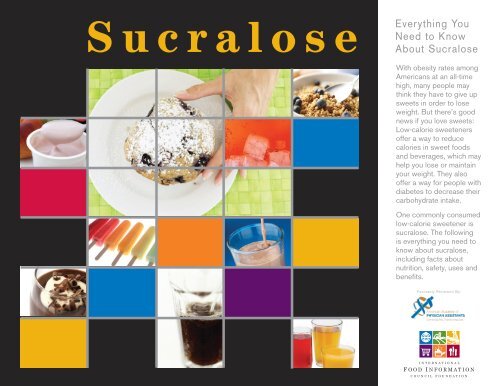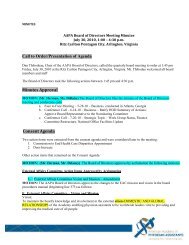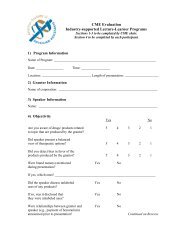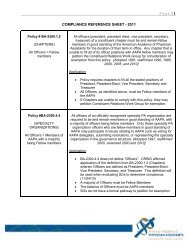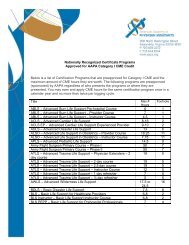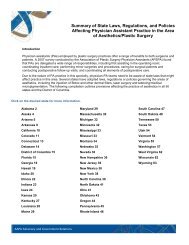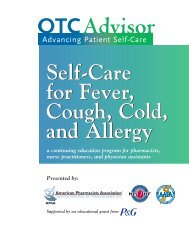Everything You Need to Know About Sucralose - American ...
Everything You Need to Know About Sucralose - American ...
Everything You Need to Know About Sucralose - American ...
- No tags were found...
You also want an ePaper? Increase the reach of your titles
YUMPU automatically turns print PDFs into web optimized ePapers that Google loves.
S u c r a l o s e<strong>Everything</strong> <strong>You</strong><strong>Need</strong> <strong>to</strong> <strong>Know</strong><strong>About</strong> <strong>Sucralose</strong>With obesity rates among<strong>American</strong>s at an all-timehigh, many people maythink they have <strong>to</strong> give upsweets in order <strong>to</strong> loseweight. But there’s goodnews if you love sweets:Low-calorie sweetenersoffer a way <strong>to</strong> reducecalories in sweet foodsand beverages, which mayhelp you lose or maintainyour weight. They alsooffer a way for people withdiabetes <strong>to</strong> decrease theircarbohydrate intake.One commonly consumedlow-calorie sweetener issucralose. The followingis everything you need <strong>to</strong>know about sucralose,including facts aboutnutrition, safety, uses andbenefits.Favorably Reviewed By:
w w w . f o o d i n s i g h t . o r gWhat is<strong>Sucralose</strong>?<strong>Sucralose</strong> adds sweetness <strong>to</strong> foodsand beverages without adding caloriesor carbohydrates. As an alternative<strong>to</strong> sugar and other calorie-containingsweeteners, it can play a role in weightmanagement programs that combinesensible nutrition and physical activity.While the process <strong>to</strong> make sucralosebegins with sucrose, or table sugar, thefinal product is different from sugar.<strong>Sucralose</strong> is made by replacing threeselect hydrogen-oxygen groups onthe sugar molecule with three chlorinea<strong>to</strong>ms, resulting in an intensely sweet,no-calorie sweetener.Unlike sugar, the body does not breakdown sucralose in<strong>to</strong> calories for energy.Yet, both sugar and sucralose activatethe same taste buds on your <strong>to</strong>ngue.Most of the sucralose people consumeis not absorbed and passes throughthe body. The little that is absorbedis excreted in the urine, and doesn’taccumulate in the body.<strong>Sucralose</strong> is available in table<strong>to</strong>psweeteners (one well-known brand isSplenda ® ) and also as an ingredientin many products, including a varietyof beverages, baked goods, desserts,dairy products, canned fruits,syrups and condiments. <strong>Sucralose</strong>is 600 times sweeter than sugar,and it can be used in place of orcombined with sugar in cookingand baking.<strong>Sucralose</strong> has been studiedextensively and has been found <strong>to</strong>be safe by experts and researchersaround the world. Governmentagencies worldwide, including theU.S. Food and Drug Administration(FDA), have also reviewed thescience on sucralose and found it<strong>to</strong> be safe for human consumption.How doessucralose fit in<strong>to</strong>a healthful diet?As a no-calorie alternative <strong>to</strong>sugar, sucralose-containing foodsand beverages still allow peoplewho are following a weight lossor weight management program<strong>to</strong> enjoy sweet, good tastingoptions. For example, a lightyogurt containing sucralose cansave 50 or more calories perserving compared <strong>to</strong> regularyogurt, and a 12-ounce glass oficed tea sweetened with sucralosecan save more than 100 caloriescompared <strong>to</strong> the same glass of teasweetened with sugar.<strong>Sucralose</strong> can be used almostanywhere sugar is used, allowingfor a variety of choices whenplanning low-calorie meals.How manycalories are insucralose?<strong>Sucralose</strong> is not metabolized bythe body for energy, and thereforeit contains zero calories. Table<strong>to</strong>psweeteners that contain sucralosealso contain other ingredientsthat provide needed texture andvolume (such ingredients arealso commonly added <strong>to</strong> otherno-calorie sweeteners). Whilethese ingredients are typicallycarbohydrates, the amount is sosmall (less than 1 gram per serving)that the calories are insignificant.
i n t e r n a t i o n a l f o o d i n f o r m a t i o<strong>Sucralose</strong>’sGlobal SafetyRecognitionDoes sucralosecause weightgain?weight management plan, theseproducts should be used in place ofthe full-calorie versions in order <strong>to</strong>reduce <strong>to</strong>tal calorie intake.<strong>Sucralose</strong> is approved for usein over 80 countries. In theUnited States, the U.S. Foodand Drug Administration (FDA)must approve all food additivesbefore they can be used infoods and beverages. The FDAapproved sucralose for certainfood and beverage categoriesin 1998, and expanded theapproval <strong>to</strong> all food andbeverage categories in 1999.Examples of government andscientific groups that havereviewed sucralose’s safetyinclude:• European Union ScientificCommittee on Food (SCF)• U.S. Food and DrugAdministration (FDA)• Food Standards Australia/New Zealand (FSANZ)• Health Protection Branch ofHealth and Welfare Canada• (Food and AgricultureOrganization/World HealthOrganization) Joint ExpertCommittee on FoodAdditives (JECFA)• Japan’s Ministry of Healthand Welfare• Countries in Africa and Asia“decades of scientificresearch clearlyshow that lowcaloriesweeteners,including sucralose,can be an effectiveaid in weight loss/management“No. Several studies have shownthat low-calorie sweeteners canactually aid in weight loss and/orweight management. For example,researchers in one study foundthat when foods and beveragescontaining sucralose were usedas part of a program <strong>to</strong> reducecalorie intake and increase levelsof physical activity, overweightchildren were able <strong>to</strong> slow theirrate of weight gain. While a fewsmaller studies have suggestedthat low-calorie sweeteners maycause cravings and/or weight gain,such an association has not beenconfirmed in larger studies, and themajority of the research still findsthat low-calorie sweeteners suchas sucralose can be helpful weightloss/weight management aids.With rising obesity rates, peopleare often looking for one “magic”solution <strong>to</strong> help them lose weight.And, while low-calorie sweetenerscan help, it is also important<strong>to</strong> practice portion control andparticipate in regular physicalactivity in order <strong>to</strong> reach weightloss goals. Also, when incorporatingfoods and beverages containinglow-calorie sweeteners in<strong>to</strong> aCan people whohave diabetesconsume foodsand beveragescontainingsucralose?Yes. <strong>Sucralose</strong> has no effect onblood glucose or insulin levelsin people with diabetes, andtherefore it is safe for them <strong>to</strong>consume. Foods and beveragessweetened with sucralose providesweet options that are lower incarbohydrates, which are helpfulfor people who have diabetes, whomust moni<strong>to</strong>r their carbohydrateintake.As with any nutritional concern,people who have diabetes shouldtalk <strong>to</strong> a registered dietitian, healthcare provider and/or diabetescare professional for advice onincorporating foods and beveragescontaining sucralose in<strong>to</strong> their diets.
n c o u n c i l f o u n d a t i o nDoes sucralosecause <strong>to</strong>othdecay?No. <strong>Sucralose</strong> does not causecavities. The bacteria in plaque donot break down or “eat” sucralose,and therefore the acids thatcan lead <strong>to</strong> cavities do not form.<strong>Sucralose</strong> does not increase thegrowth of bacteria in the mouthand does not promote <strong>to</strong>oth decay.Can pregnant andbreastfeedingwomen consumesucralose?Is sucralose safefor children?Yes. There is no evidence thatsucralose is at all harmful <strong>to</strong>children. In fact, sucralose can bepart of the solution <strong>to</strong> the growingproblem of childhood obesity byhelping <strong>to</strong> reduce calories fromsugar. Foods containing sucralose,including low-fat flavored milk,yogurt, juices, and pudding, can beincluded in a healthful meal planfor children <strong>to</strong> help ensure they aregetting all the necessary nutrients,while not getting a lot of extracalories.Yes. Anyone can consumesucralose, including pregnant andbreastfeeding women. Researchhas shown that sucralose does nothave harmful effects on pregnantwomen or their babies. Althoughsucralose may be consumedas part of a healthful pre- andpost-natal diet, a pregnant orbreastfeeding woman should talk<strong>to</strong> her physician or health careprovider about consuming thenecessary nutrients <strong>to</strong> support herand her baby’s health throughoutpregnancy and infancy.
“In bakingrecipes callingfor sugar,sucralose maybe substitutedfully orpartially forsugar and/or othersweeteners.“Products That Contain<strong>Sucralose</strong><strong>Sucralose</strong> is used <strong>to</strong> sweeten a variety of foods andbeverages. Products containing sucralose are oftenlower-calorie products, making them useful for peoplewho are trying <strong>to</strong> lose or maintain their weight. Productslabeled as “Light” or “Reduced Calorie” may use a lowcaloriesweetener <strong>to</strong> reduce the calorie content - checkthe ingredients list for products containing sucralose.<strong>Sucralose</strong> appears in over 4,000 products, including:• Dairy Products (low-fat flavored milk, light yogurt, low-fatcoffee creamer, etc.)• Cereals & cereal bars• Desserts (light pudding, light ice cream, popsicles, etc.)• Snack Foods (light canned fruit, reduced calorie bakedgoods, candy, etc.)• Beverages (light juice, iced and hot tea, diet soda, coffeebeverages, etc.)• Syrups and Condiments (light maple syrup, low-caloriejams, jellies, etc.)• Nutritional Products & Dietary Supplements<strong>Sucralose</strong> at a GlanceUsing <strong>Sucralose</strong> inCooking and Baking• <strong>Sucralose</strong> may be used in place of, or incombination with, sugar and/or other lowcaloriesweeteners <strong>to</strong> reduce the <strong>to</strong>talcalories and carbohydrates from sugar inbaked goods.• While the sweetness of sucralose is similar<strong>to</strong> sugar, the flavor, texture, and/or cookingtime of a food made with sucralose may beslightly different than the same food madewith sugar. For example, sugar adds volumeand can help retain moisture in baked goods.Sugar also has the ability <strong>to</strong> caramelize,which provides a caramel flavor and color.• With items such as sweet sauces, fruit piefillings, cheesecakes, glazes, and beverages,complete substitution of sucralose for sugaris possible.• For recipes with a high proportion of sugarand/or those that require browning, partialsugar substitution is best.For more information on sucralose and otherlow-calorie sweeteners, visit www.foodinsight.org“sucralose can be par<strong>to</strong>f the solution <strong>to</strong> thegrowing problem ofchildhood obesity byhelping <strong>to</strong> reduce <strong>to</strong>talcalorie intake“Scientific Name............................................................... <strong>Sucralose</strong>Brand Name....................................................................... Splenda ® ,s<strong>to</strong>re brandsDate Approved by FDA............................................. 1998Number of Times Sweeter Than Sugar....... 600Safe for People With Diabetes?........................ YesUse in Baking? ................................................................ YesFavorably Reviewed By:<strong>American</strong> Academyof Physician Assistantswww.aapa.orgProvided By:International Food InformationCouncil FoundationQuestions? Go <strong>to</strong> www.foodinsight.org©December 2009


